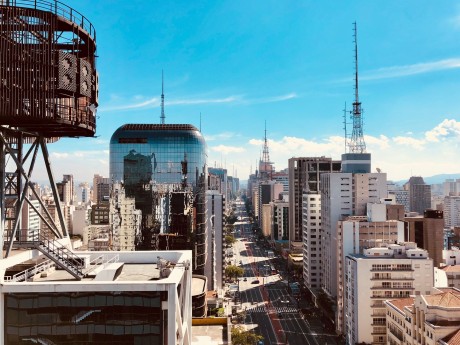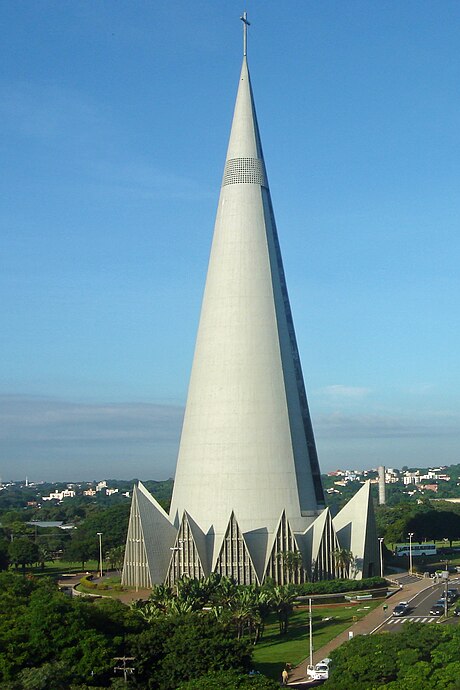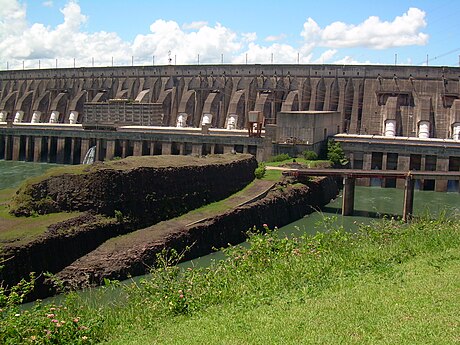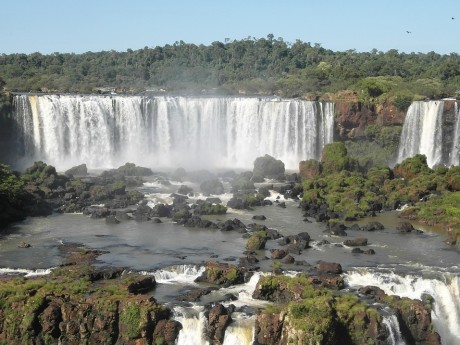Brazil: São Paulo, Maringá & Foz do Iguaçu
Embark on an unforgettable road trip in Brazil. We recommend renting a car to see awe-inspiring landscapes and create unforgettable memories along the way. In São Paulo, immerse yourself in the vibrant culture, where world-class dining, thriving arts scenes, and eclectic museums await exploration. Indulge in gourmet cuisine, visit Ibirapuera Park, and wander through bustling markets, soaking in the lively atmosphere of this dynamic urban hub.
Read more
Embark on an unforgettable road trip in Brazil. We recommend renting a car to see awe-inspiring landscapes and create unforgettable memories along the way. In São Paulo, immerse yourself in the vibrant culture, where world-class dining, thriving arts scenes, and eclectic museums await exploration. Indulge in gourmet cuisine, visit Ibirapuera Park, and wander through bustling markets, soaking in the lively atmosphere of this dynamic urban hub. Stopover for the night in the captivating city of Maringá. Explore the Maringá Cathedral for stunning architecture or stroll through Ingá Park for an oasis escape to reconnect with nature. Lastly, venture to Foz do Iguaçu, where the breathtaking Iguaçu Falls cascade in a thunderous display of nature's power and beauty. Take exhilarating boat tours that take you up close to the cascading waters and explore the surrounding parks, such as Parque das Aves, teeming with lush rainforests and diverse wildlife. Waterviews strives to offer accommodation options within walking distance of water and/or in an area of touristic interest. Our prices include taxes (but excludes local tourist taxes). Customize your trip to your personal preferences with optional activities (hit the “Add Activities’’) or change hotels, etc. Contact us for customization at no extra cost at: Service@waterviewstravel.com
Destinations
- São Paulo
- Maringá (Paraná)
- Foz do Iguaçu
Itinerary
São Paulo

The largest city of both Brazil and Latin America, São Paulo is a bustling and multicultural metropolis that should not be missed on any trip to the country. Although often overshadowed by Rio de Janeiro, São Paulo is a worthwhile destination in its own right, offering countless cultural attractions, vibrant nightlife and a thriving culinary scene. The city is home to some of Brazil’s most important museums, galleries and cultural centres, as well as some interesting architectural highlights and world-class eateries.
Read more
The largest city of both Brazil and Latin America, São Paulo is a bustling and multicultural metropolis that should not be missed on any trip to the country. Although often overshadowed by Rio de Janeiro, São Paulo is a worthwhile destination in its own right, offering countless cultural attractions, vibrant nightlife and a thriving culinary scene. The city is home to some of Brazil’s most important museums, galleries and cultural centres, as well as some interesting architectural highlights and world-class eateries.
Additional Information
São Paulo is the most visited city of Brazil, but mostly because of business and event tourism, with many of the visitors not taking much effort to explore the city. Those who do so may, however, discover one of the most complex and fascinating cities of the world, where even nearby areas may look and feel like a different city, due to São Paulo's staggering social inequality and variety of cultural influences, and its lack of comprehensive urban planning.
For instance, if you walk from one end to another of Rua Augusta (which later becomes Rua Colômbia and Avenida Europa), starting from Downtown, you will pass through: One of the city's hottest nightlife areas in Baixa Augusta A vibrant cultural and business area surrounding Avenida Paulista A variety of shopping options in the area surrounding Rua Oscar Freire The green, affluent low-rise neighbourhood of Jardim América A stream of expensive car shops in Jardim Europa The modern business district in Av. Faria Lima and the ultra-affluent neighbourhood of Itaim
Although the first impression might be that of a grey concrete jungle, soon it becomes apparent that the city has a great number of pockets of beauty, and fantastic places (and not always expensive) to dine, drink and hang out.
History
Native American Chief Tibiriçá and the Jesuit priests José de Anchieta and Manuel de Nóbrega founded the village of São Paulo de Piratininga on 25 January 1554—Feast of the Conversion of Paul the Apostle. Along with their entourage, the priests established a mission named Colégio de São Paulo de Piratininga aimed at converting the Tupi-Guarani native Brazilians to the Catholic religion. São Paulo's first church was constructed in 1616, and it was located where today is the Páteo do Colégio (metrô: Sé or São Bento station).
São Paulo was designated a city in 1711. In the 19th century, it experienced a flourishing economic prosperity, brought about chiefly through coffee exports, which were shipped abroad from the port of neighbouring city Santos. After 1881, waves of immigrants from Italy, Japan, and other European and Middle Eastern countries, such as Syria and Lebanon immigrated to São Paulo State due to the coffee production boom. Enslavement of Africans was coming to an end, due to British pressure, as the British Empire wished to introduce its machinery and industrialized products to Brazil. The government was also concerned with the fact that the population of black people was greater than that of whites, and, in an effort to "bleach the race," gave incentives to European nationals of countries such as Italy, Germany, Lithuania, Ukraine, Poland, Portugal, and Spain to immigrate. Thus, after Emancipation, with the influx of European labor and failure on the part of the racist system to include African-Brazilians, black people became increasing unemployed and discriminated against. By the beginning of the 20th century, the coffee cycle had already plummeted due to, among other factors, a sharp decline in international coffee prices and competition from other nations. The local entrepreneurs then started investing in the industrial development of São Paulo, attracting new contingents of overseas immigrants to the city. Many of those entrepreneurs had Italian, Portuguese, German, and Syro-Lebanese Christian descent such as the Matarazzo, Diniz, and Maluf.
However, due to competition with many other Brazilian cities, which sometimes offer tax advantages for companies to build manufacturing plants in situ, São Paulo's main economic activities have gradually left its industrial profile in favour of the services industry over the late 20th century. The city is nowadays home to a large number of local and international banking offices, law firms, multinational companies, advertising firms and consumer services.
Many major international and Brazilian companies have offices in São Paulo, and the Bovespa stock exchange index (Ibovespa) is considered one of the most important Latin American market indices abroad.
People
Don't be surprised at the diversity of Paulistanos. For example, São Paulo is home to the largest Japanese population outside of Japan. It is not uncommon to see businesses and churches being conducted by Chinese and Korean-Brazilians in Liberdade, which began as an Italian district, became Japanese, and now is heavily populated by Koreans and Chinese. The city's Italian influence is also very strong, with about 6 million people in the metropolitan area having Italian background. The large Arab and Jewish communities are also well represented in all levels of society, from art to real estate businesses, and notably in politics.
The citizens of São Paulo have a reputation as hard-working and industrious or shallow money-grubbers. It is common to hear that the people in São Paulo work while the rest of Brazil relaxes; even though many say this, it is plainly wrong. It is a fact, nonetheless, that the city of São Paulo alone actually contributes 15 percent of the country's gross national product (45 percent if the entire São Paulo state is taken into account).
But when Paulistanos are not working, they are clubbing. The city nightlife is as intense as it gets, which makes going to a club a total must-do.
Orientation
São Paulo's basic spot for orientation should be Avenida Paulista. From there, it's pretty easy to reach every single spot in town, be it by bus or underground transport. It lies between the neighborhoods of Bela Vista and Jardim Paulista. Av. Paulista is also within walking distance to Centro and Ibirapuera Park, which makes it the perfect place to start a walking tour.
However, central São Paulo is a very large area, and travelling from one spot to another may require that you take a cab or public transport. To find out the general direction where you are, see the street signs, as it is colour-coded: Sé/República (in Downtown): White street plate.
All other areas have blue street plates, and a bottom stripe on the following colours: Expanded Center: Grey (Expanded Center means the area limited by the Tietê river on the North, the Pinheiros river on the West, Avenida dos Bandeirantes on the South and Avenida Salim Farah Maluf on the East) Northwest: Light Green North: Dark Blue Northeast: Yellow East: Red Southeast: Dark Green South: Light Blue Southwest: Purple West: Orange
To find the direction of Downtown (most precisely Praça da Sé), just follow the direction of decreasing street numbers. That doesn't work, however, in the Santo Amaro subprefecture (South Central), neither in the Far South region; in these areas, decreasing numbers lead to Largo 13 de Maio.
Climate
São Paulo is on a mountain plateau immediatelly south of the Tropic of Capricorn, and has a humid subtropical climate with four seasons. The summer is considerably wetter than the winter. Due to the altitude temperatures are somewhat cooler than otherwise at these latitudes; for instance nighttime temperatures generally stay below +20°C throughout the year and in the winter the mercury may even in rare cases drop below freezing. On the other hand, during a summer heat wave temperatures can rise up to +40°C.
© Sourced from Wikivoyage
Maringá (Paraná)

Maringá is in Northwest Paraná. It is a planned city with ample green space, the third-largest city in the state.
Read more
Maringá is in Northwest Paraná. It is a planned city with ample green space, the third-largest city in the state.
Foz do Iguaçu

Foz do Iguaçu is a major city in the state of Paraná, Brazil. It is a gateway to both Paraguay and Argentina, and home of the famous Iguaçu Falls. Together with the cities of Ciudad del Este (Paraguay) and Puerto Iguazu (Argentina), it forms part of one the largest cultural tourism poles in South America.
Read more
Foz do Iguaçu is a major city in the state of Paraná, Brazil. It is a gateway to both Paraguay and Argentina, and home of the famous Iguaçu Falls. Together with the cities of Ciudad del Este (Paraguay) and Puerto Iguazu (Argentina), it forms part of one the largest cultural tourism poles in South America.
Additional Information
Foz do Iguaçu is so named because it sits at the mouth of the Iguaçu river, discharging into Paraná river, where lies the frontier among Brazil, Paraguay and Argentina. The word Iguaçu means "large water", in Tupi-Guarani etymology. Despite hosting one of Brazil's major tourist attractions, the city has a rather un-touristy feel, and other than the large number of hotels and occasional tri-lingual signs, it looks like any other medium-sized Brazilian city - there are practically no "tourist shopping streets" and like. There is however a new large shopping mall being constructed at Avenida das Cataratas, which shall provide additional convenience to visitors in terms of night-time shopping and gastronomy.
In the past, Foz do Iguaçu formed with a tourism pole together with the nearby city of Guaíra, which hosted the Guaíra Falls (Sete Quedas). After the construction of the gigantic Itaipu Dam in the early 1980s, the Guaíra Falls were inundated, leaving Foz do Iguaçu as the only major traveller destination in the southwestern border of the Paraná state.
© Sourced from Wikivoyage





